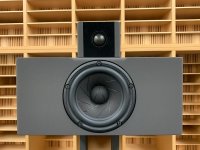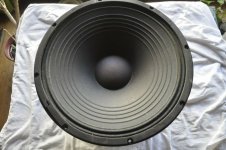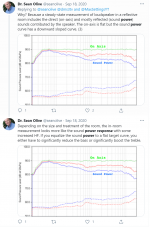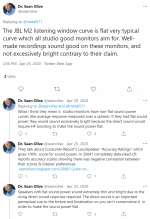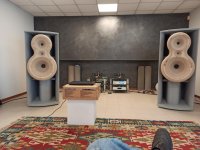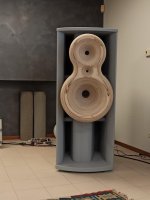I think the M2 has a 1.5" throat, if it does the rise from 10 to 20K is hard to avoid without using a 1" throat, which you have spoken about before.
I think that Marcel showed that using the throat radius as an indicator of how high in freq the waveguide can hold is false. A good waveguide will pull out the directivity. No, I think that it is the throat perturbations that create this. Again, as Marcel has shown.
I would think that since a flat on axis response is desired, and a falling in room response is desired it would also require a rising DI to accomplish this.
You are assuming that "a flat on axis response is desired". I would prefer a flat DI with both responses falling slightly.
I in no way want to argue with you just understand what is happening. I have run many of the same simulations with both mabat and bmc0's code both using OS throat's and they all show the same thing that the 1.4" throat narrows the top octave over a 1" throat with the flatter DI one's seeming to suffer the most. Is there something in the simulation that is not being taken account of or wrong in your view? I thought I read something you posted before that said larger throats couldn't pull the directivity out as high in frequency as the smaller throats, maybe I misunderstood it.I think that Marcel showed that using the throat radius as an indicator of how high in freq the waveguide can hold is false. A good waveguide will pull out the directivity. No, I think that it is the throat perturbations that create this. Again, as Marcel has shown.
I agree that the knuckles in the M2 make it harder to compare directly.
. I have run many of the same simulations with both mabat and bmc0's code both using OS throat's and they all show the same thing that the 1.4" throat narrows the top octave over a 1" throat with the flatter DI one's seeming to suffer the most. Is there something in the simulation that is not being taken account of or wrong in your view? I thought I read something you posted before that said larger throats couldn't pull the directivity out as high in frequency as the smaller throats, maybe I misunderstood it.
I agree that the knuckles in the M2 make it harder to compare directly.
I see your POV now. I'm not saying that. That a 1.4" will not pull out the directivity as much as a 1" is correct, but both will be wider than pistons of the same size. That's what I am saying.
But I do credit the knuckles with the issue as this is what one should expect with a narrowing of the throat.
I was speaking on IMD and the woofer handling midrange...
IMD in the midrange can be so obvious, that it's a waste of time to even measure it.
There's a lot of misconception about what makes a good mid(range) woofer.
A fellow countryman wrote his thesis about the subject. It's very complicated matter due to the interdependence of numerous aspects.
Some believe that modern technology/materials can solve many problems. We have copper shorting rings, optimised magnet structures, VC placement etc., but with increased power handling, comes increased excursion. Even worse are small hifi woofers that are supposed to cover 35 - 4000 Hz...
I highly respect the manufacturer, but the 5" ScanSpeak used in his near-field monitor belongs to the latter "tiny air-pump" category.
I had a pair of those, a special OEM version that cost € 549 each.
As a tiny subwoofer driver they were pretty impressive, but the midrange was plain laughable.
Attachments
Last edited:
A 15" driver at 2mm excursion can produce around 124dB at one meter, "sounding" about 5 times as loud as the Axi with no horn.
At that level, most listeners would find a 200Hz sine wave tone "uncomfortably loud" 😉
Art
This (vintage) woofer can produce a 200 Hz sine wave tone at 121.7 dB / 1 m with 0.9 mm excursion.
Attachments
Last edited:
As a tiny subwoofer driver they were pretty impressive, but the midrange was plain laughable.
yes but now apply that same logic to my diapragm and playing from 400hz-20khz, one with 350hz loading...one without loading....completely different excursion plots...still within 1mm... the same relationship we see with simultaneous deep bass and midrange, does it apply to (deep?)midrange and highest treble in the same way....1mm is pretty tiny I guess, still I'm never afraid to ask questions.
I would think that since a flat on axis response is desired, and a falling in room response is desired it would also require a rising DI to accomplish this.
This reminded me of Sean Olive's comments on the M2 measurements on Twitter, here and here.
The direct sound is an important perceptual cue to the timbre and localization so you can't compromise it in order to make the sound power flat.
Attachments
I agree that it hardly gets any better than the M2 with a 1.4" throat. It has somewhat lower overall DI which makes this stand out - it would not be so pronounced if the DI was around 9 - 10 "as usual", but you can't make it lower at the very HF.... I have run many of the same simulations with both mabat and bmc0's code both using OS throat's and they all show the same thing that the 1.4" throat narrows the top octave over a 1" throat with the flatter DI one's seeming to suffer the most.
Last edited:
The last is false for two reasons 1) it is well known that FR is the most audible distortion parameter and 2) (IMD) as NL distortion, it is true only to the extent that it is the largest, but still not audible.
I added the “IMD”to Dr Gedlees statement for clarity...so we have that statement from a audio expert and then this statement
from another audio expertIMD in the midrange can be so obvious, that it's a waste of time to even measure it.
I can only conclude that details are being left out. Is Dr Gedlee is suggesting that the distortion they Ro808 heard on that system are due to another source...or that ro808 can’t hear what he claims. Must be the first thought train....
So if it’s not imd what do we point at???? Multi tone performance? Power compression via voicecoil?....kipple gragh was mentioned....if IMD is not the issue then can we please name the sources of distortion that is confusing everyone to think it’s imd? I can only think that its a combo of power compression and dynamic limitation... has anyone had this IMD issue with the jbl M2 or a very large 2way, had this issue with midrange ???
I had a pair of Peavey SP2-XT speakers and they were the least distorted of any I have ever heard, saving the SP2g that cost twice as much. It actually sounded very like a piano, which I have in the music room for comparison. The SP2g specifies HD 2nd & 3rd harmonic 20 db down from signal 60-9000 hz @ 1w 1m. What compression happens at the rated 300 w/ch I don't know because the maximum my system hits in the living room is 70 w/ch, on the cannon shot in 1812 Overture, which is not a hifi event. These speakers are 2 way, Peavey 15" 1505-8KADT woofer + 22XT 2" horn driver on plastic horn.....
I can only think that its a combo of power compression and dynamic limitation... has anyone had this IMD issue with the jbl M2 or a very large 2way, had this issue with midrange ???
I live in a flyover state, and have never heard any JBL professional line speaker, or any competent full frequency 3 way system. I heard some Klipschhorns in 1973 but the store was playing light jazz, trumpet, brush & snare, string bass, which doesn't tell me anything about distortion. I was too obviously poor to buy that or the MacIntosh products they also sold, so the salesmen pointedly ignored me. I heard Altec-Lansing Voice of the theater at the Long Point Cinema in 1966, which impressed me so much I audited the Peavey SP2 when I found they were for sale in my tiny Metropolis.
I find your wood 3 way horns custom fabricated in the previous post rather daunting. Much more expensive than anything I could manage & a 3 way besides with all the $$ crossover components. Unless one rents a smart cell phone for $$$ a month to program a DSP, which I'm not going to do. The electricity for tri-amp is triple what a single amp would burn.
Last edited:
I guess this is not a meager three-way system but four ways ! Fun aside: I used to listen to old Peavey biradial horns for many years during the eighties. They served double duty back then - for home listening with a corner horn and for a small four-way horn PA used for disco.
Regards
Charles
Regards
Charles
Regarding the picture; I just liked the concept for trying to keep the polar tight...I could see one building a type of way or 3 channel system like this
So my buddy just bought a 3d printer, I could realistically entertain any available OWSG models at this point but I would need to design one for this particular situation is what it sounds like.... I could also fabricate one of Docalis horns if he ever gives in and produces a 350hz model lol. Then we could have our OWSG vs Loading Horns shootout probably by the fall? Not sure how long it could take, seem like printing 3d can be slow but maybe we could get it in before my work starts? My work starts back in May so....I'm not sure how long it would take to 3d print a 350hz horn, which is not small per say.... I'd do it in sections...and line the outside of the profile with Mortar...simple enough. He basically beat me to buying...I figured there'd be some better products soon, and there are...and continue to come out.
So I could literally start working towards printing one of Docalis horns but 350hz is big enough for me and I have non of his horn profiles tuned to this....if I simply scale it smaller, that seems too easy....its 150hz smaller than the last horn he gave me...Docali let me know...
Any suggesting on the waveguide...fluid I know you know things...you guys might be tired of spoon feeding but I didn't hit the lotto either...basically if I have to teach myself to make this waveguide....I will... and it won't be no time soon.
If you think you can produce a waveguide that will entertain some XO points described in this this thread, by me, of recent....here's your shot lol!!
My buddy with the 3d printer is an mechanical engineer with a background in 3d design so he'll be able to help facilitate the process.
Dear Forum Gods...( mabat XD) please produce an OSWG for the Axi, to showcase the abilities of this approach (400hz XO) so we can compare them to Docalis Horns of grandeur
If not, No love Lost =)! You are all really awesome for helping me make it this far!
So I could literally start working towards printing one of Docalis horns but 350hz is big enough for me and I have non of his horn profiles tuned to this....if I simply scale it smaller, that seems too easy....its 150hz smaller than the last horn he gave me...Docali let me know...
Any suggesting on the waveguide...fluid I know you know things...you guys might be tired of spoon feeding but I didn't hit the lotto either...basically if I have to teach myself to make this waveguide....I will... and it won't be no time soon.
If you think you can produce a waveguide that will entertain some XO points described in this this thread, by me, of recent....here's your shot lol!!
My buddy with the 3d printer is an mechanical engineer with a background in 3d design so he'll be able to help facilitate the process.
Dear Forum Gods...( mabat XD) please produce an OSWG for the Axi, to showcase the abilities of this approach (400hz XO) so we can compare them to Docalis Horns of grandeur
If not, No love Lost =)! You are all really awesome for helping me make it this far!
Last edited:
I added the “IMD”to Dr Gedlees statement for clarity...so we have that statement from a audio expert and then this statement
I can only think that its a combo of power compression and dynamic limitation... has anyone had this IMD issue with the jbl M2 or a very large 2way, had this issue with midrange ???
No I have no issues at all using 2216 and M2 waveguide 2 way.
Rob🙂
Last edited:
A fellow countryman wrote his thesis about the subject. It's very complicated matter due to the interdependence of numerous aspects.
Could you be bit more specific about this particular thesis Ro808?
Could you be bit more specific about this particular thesis Ro808?
the same relationship we see with simultaneous deep bass and midrange, does it apply to (deep?)midrange and highest treble in the same way
I've always thought the pioneers put it rather distinctly regardless of size/BW, 'if you can see it move, it's distorting' and since the distance wasn't ever stated TTBOMK, I used the then Altec [USA?] published 4 ft on axis measurement standard.
The suggestions have been made and the options laid out and argued to death from all those who have formed strong opinions either way.Any suggesting on the waveguide...fluid
At 1m I don't think this test would be particularly informative, I've been distracted enough modelling things for other people to the point I have not done enough on my own projects, so at least for the foreseeable future from me I say learn to use the tools that are available and in the mean time enjoy the horn you already have that you seem to like 🙂
- Home
- Loudspeakers
- Multi-Way
- Is it possible to cover the whole spectrum, high SPL, low distortion with a 2-way?
